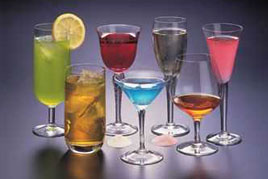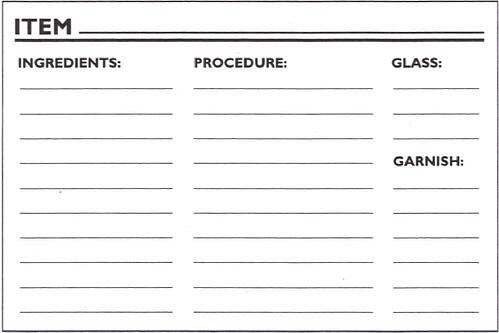Standardizing & Optimizing Serving Practices
By Chris ParryAtlantic PublishingEstablishing House Drink Recipes
 A bartender makes a good drink with originality, panache, speed and skill - but a great drink starts with the boss. You determine the drink menu, you determine the recipes to be used and you set the price and make the rules. Your staff just follows your lead. In many bars, it's left to individual members of staff to know the "standard" formulas for cocktails and mixed drinks. Everyone is supposed to know that a Tequila Sunrise has one shot of tequila, right? Or is it two? Maybe it's a shot and a half... Profits are too hard won to just throw away alcohol when your staff crosses their wires about your drink recipes. Some easy steps to ensuring standardization of your house recipes include:
A bartender makes a good drink with originality, panache, speed and skill - but a great drink starts with the boss. You determine the drink menu, you determine the recipes to be used and you set the price and make the rules. Your staff just follows your lead. In many bars, it's left to individual members of staff to know the "standard" formulas for cocktails and mixed drinks. Everyone is supposed to know that a Tequila Sunrise has one shot of tequila, right? Or is it two? Maybe it's a shot and a half... Profits are too hard won to just throw away alcohol when your staff crosses their wires about your drink recipes. Some easy steps to ensuring standardization of your house recipes include:
- Recipe lists. Make sure when you take on new staff they receive detailed recipe lists to take home and look over before they start their first shift. It doesn't cost you a lot to photocopy a few pages of text and give them to your staff, so make sure there's no excuse for them not to know as much as they can before they start mixing on your dime.
- Recipes on display. Ensure that there are either laminated index cards or recipes listed behind the bar at all times so that any member of staff - even emergency fill-ins and temps - can see exactly what is needed to prepare each drink - no more, no less. Below is an example of a recipe card and the information it should contain:

- Cocktail menus. When you leave cocktail menus on tables, make sure that each one shows exactly what is in the drink - not just the ingredients, but the ounce amounts of each. This will not only serve as a more informative drink menu to your customers, but will also allow them to more accurately measure what they've consumed over the course of the night.
- Premium ingredients. If you use premium or middle-shelf ingredients in your cocktails, make sure that your cocktail menus make a point of that fact by showing the brands used. There's no point in hiding the fact that your base spirits and liqueurs are of a higher quality than those of your competition, especially because your liquor distributor might chip in for some of the cost of printing if they're being marketed in your literature in this fashion.
- Accuracy. Make certain that the cocktail and mixed-drink recipes give a clear indication of what glass is to be used, what garnish should be used, for how long and on what setting any blended drink should be blended and what brands of alcohol should be used for their creation. If you leave anything out, you can bet someone will get it wrong - and with alarming regularity.
- Bartending recipe computer programs. For example, Interworlds Software's "BarBack for Windows" can tell your staff how to create a drink even if a customer asks for something ridiculously obscure. BarBack includes over 10,000 different drink recipes, as well as information on glassware, ingredients, mixing methods and garnishes. Rather than taking away from the skills of your staff, insightful programs such as these actually complement their skills to ensure your customers get exactly what they want in the quickest possible time. BarBack can be downloaded at www.barback.com .
Ensure Quality & Avoid Wastage
Mixed Drink Tips
Making a good mixed drink isn't always a matter of A + B = C. In fact, there are numerous small details that can contribute to turning your creation into something just that little bit better than the norm and, more still, that can help you keep your ingredients at peak freshness and productivity. Consider the following:
 Champagne wastage. Many mixed drinks require champagne or sparkling white wine as an ingredient. Opening a fresh bottle for one drink can be wasteful. Consider purchasing a champagne bottle resealer for your bar, and make sure your bar staff knows how to use it.
Champagne wastage. Many mixed drinks require champagne or sparkling white wine as an ingredient. Opening a fresh bottle for one drink can be wasteful. Consider purchasing a champagne bottle resealer for your bar, and make sure your bar staff knows how to use it.
- Keep champagne fresh. If you have a steady flow of champagne drinks in your bar, just drop the handle of a metal spoon into the top of the champagne bottle and put it back in the fridge. This will keep the sparkle in your champagne for up to 12 hours.
- Is fresh-squeezed orange and lemon juice a selling feature of your cocktail menu? If so, you should know that you'll get a lot more juice from lemons and oranges if you soak them in warm water for a while before juicing them.
- Stir, don't shake. When a mixed drink consists of clear liquids and/or carbonated beverages, stir it - don't shake it. You don't want your clear liquids to bruise, nor your bubbles to go flat, and shaking the concoction guarantees both will happen.
- "Difficult ingredients." Mixed drinks containing juices, sugar, eggs, cream, milk, or any other difficult-to-mix ingredient should be shaken - and shaken like crazy. Don't just give the contents a three-second rock around the mixer; give 'em heck!
- Adding eggs. When you shake a drink that requires an egg, add an ice cube to the shaker. This will help break up the egg and allow it to blend into the drink more easily.
- Prevent dripping. When serving wine or champagne from the bottle, a clean piece of wax paper rubbed along the rim of the bottle will prevent any dripping when you pour.
Serving Quality Drinks
 The difference between a good and great martini is very small, but very important. The quality of your cocktail menu should be of paramount importance to you. The methods by which those cocktails are prepared should be a point of pride for all concerned.
The difference between a good and great martini is very small, but very important. The quality of your cocktail menu should be of paramount importance to you. The methods by which those cocktails are prepared should be a point of pride for all concerned.
- Presentation. The color and presentation of any exotic mixed drink is key, and by adjusting the amounts of key ingredients, the bartender can not only change the color of a drink, but can also adapt it to suit any taste. Impress the customers by asking how they like their drinks mixed. Would he like it sweet? Does she like it dry? Maybe a little easy on a key ingredient? Often they'll have no preference, but in asking you'll impress the finicky customer.
- The process of drink creation can be as important as the drink itself. A little showmanship in the preparation of a drink may slow the process down a touch. Also, if the performance is good and the bartender shows personality, your customers might not mind a little longer wait.
- Garnishes. Maraschino cherries, olives, a sprig of mint, a stick of celery, banana, lemon, lime, all carefully prepared, an investment in fridge space, and a bartender who is quick with a paring knife - they can all set your mixed drinks off with a sparkle. The right garnish is as important as the right ingredients.
- Novelty glassware. Most bars consider glassware as merely a vessel in which to serve drinks, but the clever operators see that using exotic and novelty glassware and building the cost of the glass into the drink price can bring customers flocking to that drink in order to get the free glass.
The Service Bar
 The service bar is an area of the bar dedicated to the servers only. If designed well it can greatly improve the flow of drinks from the bar to the customers. Alternately, if your service bar is not designed well, it can add yet another delay in an already-crowded process. When setting up a service bar, the things that should be considering are:
The service bar is an area of the bar dedicated to the servers only. If designed well it can greatly improve the flow of drinks from the bar to the customers. Alternately, if your service bar is not designed well, it can add yet another delay in an already-crowded process. When setting up a service bar, the things that should be considering are:
- Layout. Will your staff need to make a long trip, past waiting customers, to get to your drinks server? Placing the service area off to the side of the bar might seem like a good plan when the bar is empty, but when it's full, a drinks server who has to yell to be heard is a disgruntled drinks server - and a frequently delayed one.
- Drinks station.Is everything the bartender needs to prepare drinks positioned within six feet (a step and a reach) from a drink preparation area? If it isn't, you're only adding waiting time, opportunity for spillage and even waste to the drinks serving process.
- How far do your drinks servers have to travel to reach your customers? Do you seriously expect your server to negotiate a heavy crowd with 12 drinks on his or her tray and not encounter spillage? Clear the way. Improve not just your server's efficiency but also customer traffic flow.
- Service bar communication. If you have a bartender or bar devoted purely to drinks service, consider providing your servers with radio headsets that will allow them to communicate a drinks order to the bar from the floor. This simple move can save your servers from making literally hundreds of trips across the floor a night and can slash service times considerably.
Glass-Handling Rules
Too often, bar staff think of glasses as disposable partyware and all but ignore the fundamental rules of handling drink service equipment. Make your bar staff aware of the following, or you could find yourself in hot water down the road when someone complains:
- Never, ever, use glasses as ice scoops. A tiny chip of glass falling into your ice bin can cause a great deal of injury, and bar glassware certainly isn't designed to shovel rocks of ice. Along the same lines, any time a glass breaks in or near an ice bin, the entire ice bin needs to be emptied and the contents disposed of before it can be used in the preparation of another drink.
- Staff should never touch the upper half of a glass in the act of serving a drink. It's unhygienic; it looks terrible to the customer; and the glass will be much more susceptible to breakage if it's being handled regularly in this manner.
- Stemmed glasses. They're far more susceptible to breakage than most other types of glasses - not to mention usually more expensive. Make sure that all staff take extra care in the handling of these items, perhaps even to the point of washing them by hand.
- Inspect. All glasses need to be inspected, if only briefly, before they're used in a drink order. A lipstick smudge, chip, crack or remnants of a previous drink are not only off-putting to a customer, but they're also hazardous to the customer's health.
This article is an excerpt from the Food Service Professional Guide to Bar & Beverage Operation, authored by Chris Parry, published by Atlantic Publishing Company. This excerpt has been reprinted with permission of the publisher. To purchase this book go to:
Atlantic Publishing Company
Amazon.com







